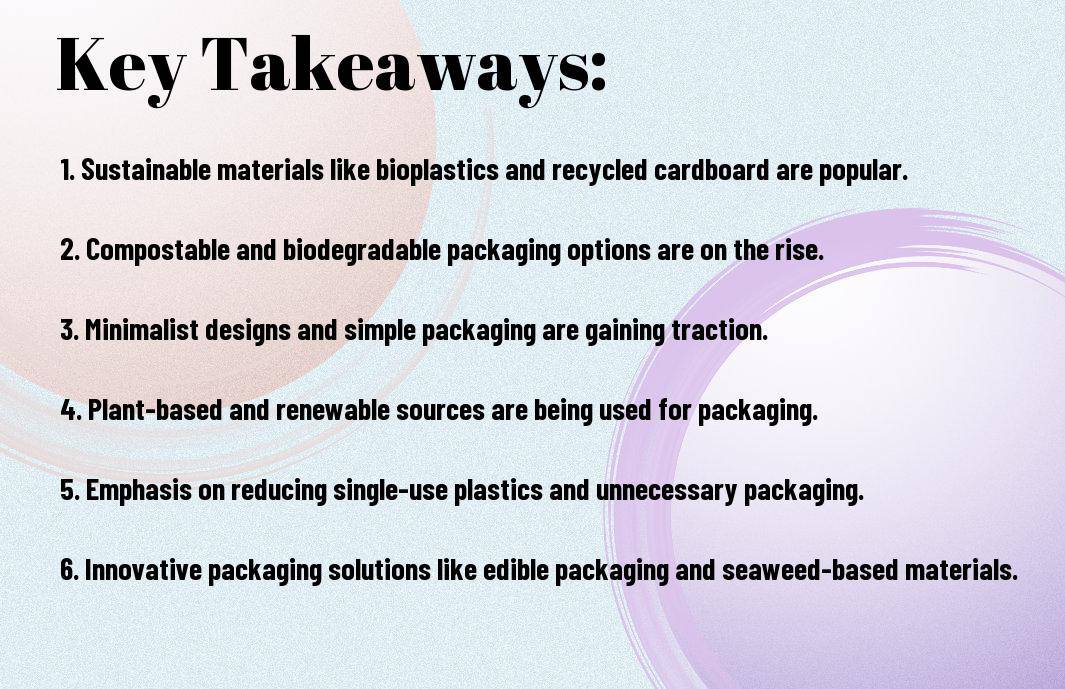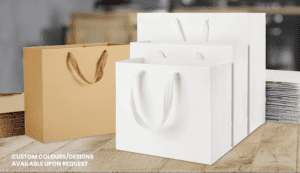Peruse this informative blog post to uncover the latest trends in eco-friendly packaging for the food and drink industry. Whether you’re a producer, distributor, or consumer, it’s crucial to stay updated on the environmentally sustainable packaging options available to you. In this post, we will delve into the most cutting-edge innovations in environmentally friendly packaging, as well as the benefits and challenges associated with these trends. By the end, you’ll be well-equipped to make informed decisions about your packaging choices.
Key Takeaways:
- Biodegradable and compostable materials: The latest trend in eco-friendly packaging for the food and drink industry involves the use of biodegradable and compostable materials such as bio-plastics, paper, and cardboard. These materials break down easily in the environment, reducing the impact of packaging waste on the planet.
- Minimalist and recyclable designs: Another trend is the use of minimalist packaging designs, which not only reduce the amount of material used but also make it easier to recycle. By opting for simple, recyclable packaging, food and drink companies can reduce their environmental footprint.
- Innovative packaging alternatives: Food and drink companies are also exploring innovative packaging alternatives such as edible packaging, reusable containers, and plant-based materials. These alternatives offer environmentally friendly solutions while also appealing to eco-conscious consumers.

Material Innovations in Eco-friendly Packaging
As consumers become more conscious of their environmental impact, there is a growing demand for eco-friendly packaging within the food and drink industry. To meet this demand, packaging manufacturers are constantly innovating and developing new materials that are sustainable, biodegradable, and compostable. In this chapter, we will explore the latest trends in material innovations for eco-friendly packaging.
The Rise of Biodegradable and Compostable Materials
The use of biodegradable and compostable materials in packaging has gained significant momentum in recent years. These materials are designed to break down naturally over time, reducing the amount of waste that ends up in landfills. Biodegradable packaging is made from organic materials such as plant-based plastics and bio-based polymers, while compostable packaging is designed to break down into nutrient-rich compost. These materials offer a sustainable alternative to traditional packaging, reducing the environmental impact of your products.
Reusable and Refillable Packaging Advancements
Another notable trend in eco-friendly packaging is the advancement of reusable and refillable packaging options. This approach involves designing packaging that can be reused multiple times or refilled with new products, reducing the need for single-use packaging. By incorporating reusable and refillable packaging into your product line, you can significantly reduce the amount of packaging waste generated by your brand, making a positive impact on the environment.
Design Trends in Eco-friendly Packaging
In recent years, the global shift towards sustainability has significantly impacted the food and drink industry, driving the demand for eco-friendly packaging solutions. With the rise of consumer awareness and environmental consciousness, there is a growing need for packaging that not only preserves the quality and freshness of products but also minimises its impact on the planet. To stay ahead of the curve, understanding the latest design trends in eco-friendly packaging is crucial. If you want to know more about the sustainable packaging trends to look for in the coming years, you can read a detailed article here.
Minimalism in Packaging Design
When it comes to eco-friendly packaging, minimalism is a key design trend that continues to gain momentum. Embracing a minimalist approach not only reduces the overall environmental impact but also provides a clean and sleek aesthetic. By simplifying the design and focusing on essential elements, you can eliminate unnecessary waste and materials while keeping the packaging highly functional and visually appealing. This trend also aligns with the growing consumer preference for simplicity and transparency in product packaging.
Innovative and Functional Design in Eco-friendly Packaging
Innovative and functional design is another major trend in eco-friendly packaging, as it focuses on creating packaging solutions that are not only sustainable but also highly functional and practical. From biodegradable materials to multifunctional designs, the emphasis is on finding creative ways to reduce waste and improve usability. This trend encourages the use of innovative technologies and materials that extend shelf life, enhance convenience, and provide a positive user experience. By prioritising both sustainability and functionality, brands can meet the evolving needs of consumers while reducing the environmental impact of their packaging.
By staying informed about the latest design trends in eco-friendly packaging, you can position yourself at the forefront of sustainable packaging practices. Embracing minimalism and innovative design not only reflects your commitment to environmental responsibility but also enhances your brand’s appeal to eco-conscious consumers. Incorporating these design trends into your packaging strategy will not only benefit the planet but also contribute to the long-term success of your business.
Role of Technology in Eco-friendly Packaging
Technology plays a crucial role in the development of eco-friendly packaging for the food and drink industry. It enables the creation of innovative materials, processes, and designs that are more sustainable and environmentally friendly.
The Impact of Digital technology on packaging
Digital technology has revolutionised packaging by allowing for more efficient and sustainable practices. For example, digital printing has significantly reduced the use of harmful chemicals and wastage associated with traditional printing methods. Additionally, digital tools and software have enabled manufacturers to optimise packaging designs for minimal material usage while maintaining product protection, reducing the overall environmental impact of packaging.
Sustainable Packaging and the Internet of Things
The Internet of Things (IoT) has enabled the development of smart, sustainable packaging solutions. Through the use of IoT sensors and devices, packaging can now be designed to provide real-time information on product freshness and storage conditions. This not only reduces food waste by ensuring the quality and safety of products but also allows for more efficient supply chain management, further reducing environmental impact.
Global Perspective on Eco-Friendly Packaging
When it comes to eco-friendly packaging, the food and drink industry is constantly evolving to meet the demands of an increasingly environmentally conscious market. According to a blog post on Food Packaging Technologies and Trends, the global perspective on eco-friendly packaging is shifting towards sustainable and innovative solutions that reduce waste and environmental impact.
Eco-friendly packaging trends in Europe
In Europe, there has been a significant emphasis on reducing single-use plastics and embracing biodegradable and compostable packaging options. The European Union has implemented regulations to reduce plastic waste, which has led to a surge in the development and adoption of eco-friendly packaging solutions across the food and drink industry. As a result, you can expect to see a growing number of products in eco-friendly packaging options, such as paper-based materials, compostable plastics, and reusable containers, in the European market.
Eco-friendly packaging trends in the United States
In the United States, there is a growing awareness of the environmental impact of packaging waste, driving the demand for eco-friendly solutions. Companies are increasingly turning to sustainable packaging alternatives, such as plant-based or recycled materials, to reduce their carbon footprint. You will also notice a rise in initiatives aimed at promoting recycled and recyclable packaging, as well as a shift towards more efficient and eco-friendly packaging designs that minimise material usage and waste. As a result, the market is seeing a gradual but significant shift towards eco-friendly packaging options in the US, with a strong focus on reducing plastic pollution and improving overall sustainability.
Conclusion
Taking this into account, it is clear that the food and drink industry is prioritizing eco-friendly packaging solutions to lessen the environmental impact of their products. You have seen how the latest trends include the use of compostable and biodegradable materials, as well as innovative designs that minimize waste. It is important for you to stay updated on these trends and consider implementing them in your own packaging strategies to align with consumer demands for sustainable and environmentally friendly choices.
FAQ
Q: What are the latest trends in eco-friendly packaging for the food and drink industry?
A: The latest trends in eco-friendly packaging for the food and drink industry include biodegradable packaging materials, compostable packaging, sustainable packaging solutions, innovative packaging designs, and reusable packaging options.
Q: What are biodegradable packaging materials?
A: Biodegradable packaging materials are substances that can be broken down by bacteria or other living organisms, resulting in the production of natural materials like water, carbon dioxide, and biomass. These materials are made from renewable resources such as plant-based polymers and natural fibres.
Q: What is compostable packaging?
A: Compostable packaging refers to materials that can easily break down into non-toxic components in a composting environment. These materials contribute to the production of nutrient-rich soil, promoting sustainable waste management and circular economy practices.
Q: How are sustainable packaging solutions beneficial for the food and drink industry?
A: Sustainable packaging solutions help reduce the environmental impact of the food and drink industry by minimising waste, lowering carbon emissions, and conserving natural resources. Additionally, they appeal to environmentally-conscious consumers and support brand reputation and customer loyalty.
Q: What are some examples of innovative packaging designs in the eco-friendly packaging sector?
A: Innovative packaging designs in the eco-friendly packaging sector include edible packaging, seaweed-based packaging, plantable packaging embedded with seeds, and packaging made from food waste. These designs aim to provide sustainable alternatives to traditional packaging while offering unique, value-added features.



